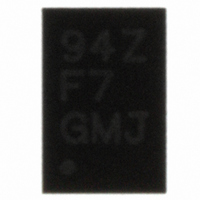ISL6294IRZ-T Intersil, ISL6294IRZ-T Datasheet - Page 6

ISL6294IRZ-T
Manufacturer Part Number
ISL6294IRZ-T
Description
IC CHARGER LI-ION SGL 2X3 8DFN
Manufacturer
Intersil
Series
-r
Datasheet
1.ISL6294IRZ-T.pdf
(9 pages)
Specifications of ISL6294IRZ-T
Function
Charge Management
Battery Type
Lithium-Ion (Li-Ion), Lithium-Polymer (Li-Pol)
Voltage - Supply
4.5 V ~ 6.5 V
Operating Temperature
-40°C ~ 85°C
Mounting Type
Surface Mount
Package / Case
8-VFDFN Exposed Pad
Battery Chemistry
Lithium-Ion (Li-Ion), Lithium-Polymer (Li-Pol)
Lead Free Status / RoHS Status
Lead free / RoHS Compliant
Other names
ISL6294IRZ-TR
Available stocks
Company
Part Number
Manufacturer
Quantity
Price
Company:
Part Number:
ISL6294IRZ-T
Manufacturer:
Intersil
Quantity:
20 000
Part Number:
ISL6294IRZ-T
Manufacturer:
INTERSIL
Quantity:
20 000
to LOW when the trickle charge starts and rises to HIGH at
the EOC. After the EOC is reached, the charge current has
to rise to typically 76% I
again, as shown in Figure 4. The current surge after EOC
can be caused by a load connected to the battery.
A thermal foldback function reduces the charge current
anytime when the die temperature reaches typically +115°C.
This function guarantees safe operation when the printed
circuit board (PCB) is not capable of dissipating the heat
generated by the linear charger. The ISL6294 accepts an input
voltage up to 28V but disables charging when the input
voltage exceeds the OVP threshold, typically 6.8V, to protect
against unqualified or faulty AC adapters.
PPR Indication
The PPR pin is an open-drain output to indicate the
presence of the AC adapter. Whenever the input voltage is
higher than the POR threshold, the PPR pin turns on the
internal open-drain MOSFET to indicate a logic LOW signal,
independent on the EN pin input. When the internal open-
drain FET is turned off, the PPR pin should leak less than
1µA current. When turned on, the PPR pin should be able to
sink at least 10mA current under all operating conditions.
The PPR pin can be used to drive an LED (see Figure 1) or
to interface with a microprocessor.
Power-Good Range
The power-good range is defined by the following three
conditions:
where the V
voltage comparator, discussed shortly, and the V
overvoltage protection threshold given “Electrical
Specifications” on page 2. All V
hysteresis, as given in “Electrical Specifications” on page 2.
The charger will not charge the battery if the input voltage is
not in the power-good range.
Input and Output Comparator
The charger will not be enabled unless the input voltage is
higher than the battery voltage by an offset voltage VOS.
The purpose of this comparator is to ensure that the charger
is turned off when the input power is removed from the
charger. Without this comparator, it is possible that the
charger will fail to power down when the input is removed
and the current can leak through the PFET pass element to
continue biasing the POR and the Pre-Regulator blocks
shown in the Block Diagram on page 5.
1. V
2. V
3. V
IN
IN
IN
> V
- V
< V
BAT
POR
OVP
OS
> V
is the offset voltage for the input and output
OS
REF
for the CHG signal to turn on
6
POR
, V
OS
, and V
OVP
OVP
have
is the
ISL6294
CHG Indication
The CHG is an open-drain output capable to at least 10mA
current when the charger starts to charge and turns off when
the EOC current is reached. The CHG signal is interfaced
either with a micro-processor GPIO or an LED for indication.
EN Input
EN is an active-low logic input to enable the charger. Drive
the EN pin to LOW or leave it floating to enable the charger.
This pin has a 200kΩ internal pulldown resistor so when left
floating, the input is equivalent to logic LOW. Drive this pin to
HIGH to disable the charger. The threshold for HIGH is given
in “Electrical Specifications”on page 2.
IREF Pin
The IREF pin has the two functions as described in the Pin
Description section. When setting the fast charge current,
the charge current is guaranteed to have 10% accuracy with
the charge current set at 500mA. When monitoring the
charge current, the accuracy of the IREF pin voltage vs the
actual charge current has the same accuracy as the gain
from the IREF pin current to the actual charge current. The
accuracy is 10% at 500mA and is expected to drop to 30% of
the actual current (not the set constant charge current) when
the current drops to 50mA.
Operation Without the Battery
The ISL6294 relies on a battery for stability and is not
guaranteed to be stable if the battery is not connected. With
a battery, the charger will be stable with an output ceramic
decoupling capacitor in the range of 1µF to 200µF. The
maximum load current is limited by the dropout voltage or
the thermal foldback.
Dropout Voltage
The constant current may not be maintained due to the
r
resistance of the pass FET is 1.2Ω the maximum operating
temperature, thus if tested with 0.5A current and 3.8V
battery voltage, constant current could not be maintained
when the input voltage is below 4.4V.
Thermal Foldback
The thermal foldback function starts to reduce the charge
current when the internal temperature reaches a typical
value of +115°C.
DS(ON)
limit at a low input voltage. The worst case on
July 9, 2007
FN9174.4











